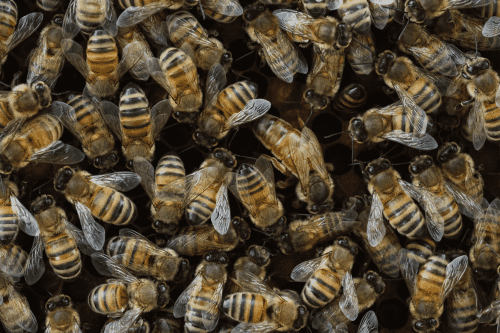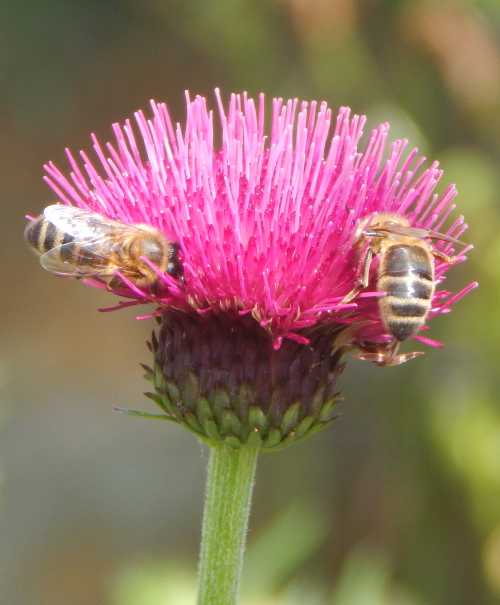Diapause vs Hibernation In Bees? What's The Difference?
Although the term 'hibernation' is often used to describe the overwintering behaviour of bees, you may see references to the term 'winter diapause'.
Here, we'll look at how hibernation and diapause are different and how these terms are applied to bees.
What’s The Difference Between Hibernation And Diapause?
Of relevance here are the following points explained in simple terms:
Hibernation
-
Hibernation is a winter dormant state, essentially a deep sleep entered by fully
developed, warm-blooded animals.
- This state helps the animal conserve energy resources and
survive hostile exterior conditions (extreme cold and lack of food).
- During a hibernation period, the internal temperature of a warm-blooded animal will drop.
Diapause
-
Diapause is a hormonally programmed arrest in development and metabolic
processes. This state is commonly described in cold-blooded animals, such as
amphibians and invertebrates including insects.
- Diapause may occur in insects in response to adverse external
conditions, such as lack of food, a harsh winter, flood or very dry season. Whilst
diapause can be seasonal in insects, this is not always the case.
- Diapause can occur at different stages of the life cycle, and can occur multiple times.
The Development Of The Terms 'Hibernation' And 'Diapause'
Originally, the term "hibernation" was also used in the 19th century to describe winter dormancy in insects (Rennie 1857)1.
The term "diapause" was introduced later and specifically for insects when American entomologist, William Morton Wheeler (1893)2 used it to describe the developmental stage of locust eggs during the winter1.
In subsequent years, there then followed a continuation of effort to describe the different factors affecting diapause, as well as how ‘diapause’ was to be distinguished from ‘dormancy’, ‘rest’ or ‘torpor’1.
Examples Of Different
Diapause Behaviour In Bees
"The diapause phase allows annual bee species to survive unfavourable environmental conditions, such as periods of extreme temperature or a lack of floral resources, and to synchronize their phenology with conspecific individuals."
- Treanore & Amsalem (2020)3
According to Santos et al (2020)4:
- Most social species diapause as adults or do not diapause,
whereas most solitary species diapause during development.
These different diapause behaviours could have important implications for social behaviour in the adult phase in social and subsocial species and may indicate that diapause strategies play a role in the evolution of sociality in bees. - Species from the Osmia (mason bee) genus of solitary bees diapause as adults, but remain inside their pupal cocoon.
- The subsocial species Xylocopa virginica and Ceratina calcarata diapause as adults in their natal nest prior
to mating.
- In contrast, species from the predominately eusocial genera Lasioglossum, Halictus and Bombus mate before entering diapause.
- The length of diapause is also variable among bees. Several
species require an additional year or more to reach maturity.
For example: Osmia montana, Osmia californica and Osmia iridis remain in diapause for either one or two years. Perdita nuda and the parasite Sphecodes sp. may remain in diapause for up to 35 months.
Do Bees Hibernate Or Enter Winter Diapause?
In reality, although ‘hibernation’ is sometimes used to describe the overwintering stage in the life cycle of bees, technically, the term ‘winter diapause’ is correct.
"In insects, "hibernation" is a misnomer. The correct term is diapause, which can be seasonal like vertebrate hibernation, but not necessarily so."
- Eric R. Heaton; Insectpedia. A Brief Compendium Of Insect Lore. Princeton University Press 2022.
Bees are insects and therefore, according to Heaton and others, the term 'diapause' applies.
Nevertheless, it appears the term 'hibernation' is often used interchangeably with 'winter diapause', including in various text books, scientific papers and articles.
For example, Vogt et al 20115 referring to their study of bumble bees write [emphasis mine]:
"First, the Alaskan bees emerged almost immediately (within 1 or 2 days) after the first willow blossoms began to open (while the ground was still snow covered except for a few bare patches).
Within 2 days after emerging from hibernation, the first queens were already nest hunting and (or) carrying pollen, and ovary masses were increasing markedly."
Makinson et al (2019)6 also use the term 'hibernation' in reference to Bombus terrestris:
"Post-hibernating queens consume nectar and pollen to nourish their developing ovaries, and then each bee seeks out a suitable nest site (Cumber, 1949;Free & Butler, 1959;Alford, 1975)"
There are many, many more examples, but it should always be remembered that science is constantly evolving, and no doubt some scientific terms may fall in and out of favour and regular use, even within the scientific community.
References
1. Tougeron, Kévin. (2019). Diapause research in insects: historical review and recent work perspectives. Entomologia Experimentalis et Applicata. 167. 27-36. 10.1111/eea.12753.
2. Wheeler W.M., 1893. A Contribution to Insect Embryology. Ginn Publishing, Winchester, USA.
3. Erin Treanore, Etya Amsalem, The effect of intrinsic physiological traits on diapause survival and their underlying mechanisms in an annual bee species Bombus impatiens, Conservation Physiology, Volume 8, Issue 1, 2020, coaa103, https://doi.org/10.1093/conphys/coaa103,
4. Santos PKF, Arias MC, Kapheim KM. Loss of developmental diapause as prerequisite for social evolution in bees. Biol Lett. 2019 Aug 30;15(8):20190398. doi: 10.1098/rsbl.2019.0398. Epub 2019 Aug 14. PMID: 31409242; PMCID: PMC6731480.
5. Vogt, F. & Heinrich, Bernd & Dabolt, Thomas & McBath, Heather. (2011). Ovary development and colony founding in subarctic and temperate-zone bumblebee queens. Canadian Journal of Zoology. 72. 1551-1556. 10.1139/z94-206.
6. Makinson, James & Woodgate, Joseph & Reynolds, Andy & Capaldi, Elizabeth & Perry, Clint & Chittka, Lars. (2019). Harmonic radar tracking reveals random dispersal pattern of bumblebee (Bombus terrestris) queens after hibernation. Scientific Reports. 9. 10.1038/s41598-019-40355-6.
If you found this page helpful or interesting, I'd really be grateful if you would share it with others - if not this page, perhaps another, such as Gardening For Bees.
Thank you so much :) .

